Perfect for cooking, soapmaking, and skincare, beef tallow is a super versatile fat that is healthy and nourishing. And, it’s simple to make at home.
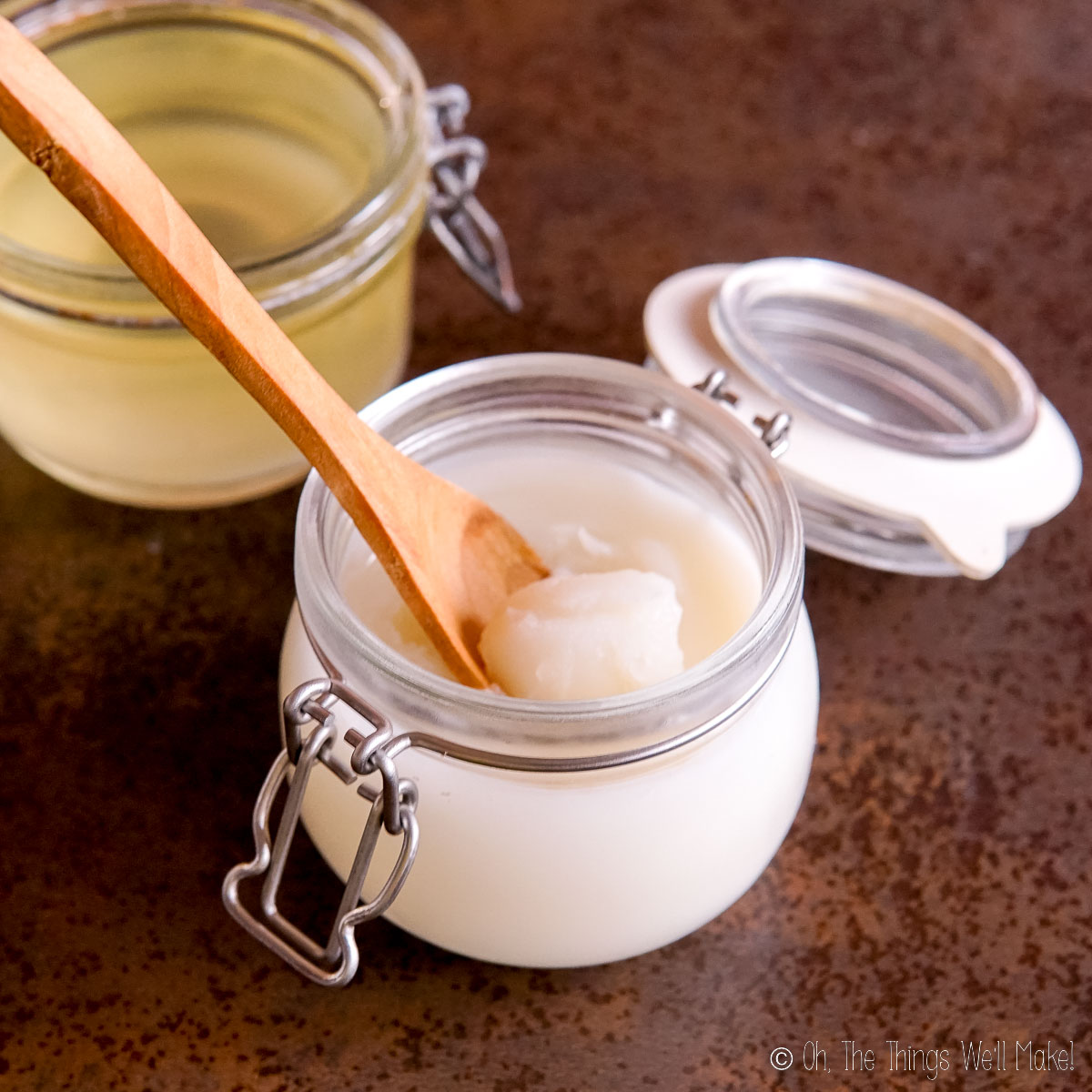
While I have been making homemade lard for years, I hadn’t started making my own tallow until recently. Here in Spain, it’s quite easy to get ahold of pork fat as they sell it for use in Valencian Puchero. You don’t have to worry about people looking at you strangely when you buy it. That is unless you’re buying several kilos at once (something I may or may not have done at times).
I had a hard time finding a good butcher who would save me the beef fat trimmings. As more people see how useful it can be, though, it’s getting easier to find. Recently, I was able to find two great new sources of beef fat here in Spain. So, I decided to order some, and make tallow from both, to compare.
What is beef tallow?
Beef tallow is a form of rendered beef fat that is commonly used in cooking, soapmaking, and skincare. It is obtained by gently cooking beef fat over heat until it liquefies, then filtering out the solids. The remaining liquid fat is then cooled until it hardens. This process removes water, proteins, and other impurities resulting in a versatile fat that will keep for a long time.
The term “tallow” refers to the hardened product left behind after the fat has been melted and separated from the solids. When cooled, tallow becomes a semi-solid material that resembles candle wax, but is softer, with a texture more like butter. Today, we’ll make beef tallow, but you can also use the same process to make tallow from the fat of other animals.
Tallow vs. lard and shmaltz
While beef tallow is rendered from beef fat, and there are many sorts of tallow (like bear tallow, sheep tallow, goat tallow, and deer tallow), not all rendered fat is called tallow. Lard is rendered pork fat from pigs and shmaltz is rendered chicken fat.
Some rendered fat doesn’t appear to have a special name. When you save the fat given off by the skin of duck breasts, for example, it’s generally just referred to as duck fat. In the same way, goose fat is called, well, goose fat.
Ingredients
As you can imagine, the only necessary ingredient for making tallow is suet. Suet is the hard fat from certain animals like cattle and some other animals, mostly ruminants. Some people like to try to purify their tallow by cooking the fat down with some salt and water, but those ingredients are completely optional.
Yield
The yield can vary a lot depending on the fat used and how you process it. That said, you’ll need about one pound of beef suet per 1-2 cups of tallow.
Procedure
The procedure is very simple. In a bit of time, you’ll be able to reap the benefits of your homemade delicious tallow!
Prepare the fat pieces
First, you’ll want to prepare the fat. You can remove most of the meat first, but I don’t worry about trying to perfectly remove it all.
The supplier who generously sent me some beef fat (through a friend who owns a restaurant) told him that they like to begin the process by soaking the pieces of fat in ice water to get out most of the impurities. This allows you to begin with a really white-looking fat which improves your chances of getting a white tallow. (More about the color in a bit…) While you could skip this step, I have found that it does help to remove any remaining blood, and really cleans up the pieces well. It also slightly hardens them, making them easier to cut into small pieces.
Once you have soaked the suet in ice water for about an hour, remove it and cut it into smaller pieces. Depending on how clean the suet was, to begin with, you may want to cut off any pieces of bone, cartilage, and meat first. To make the rendering process go more quickly, you could even grind the fat in a meat grinder or a heavy-duty food processor.
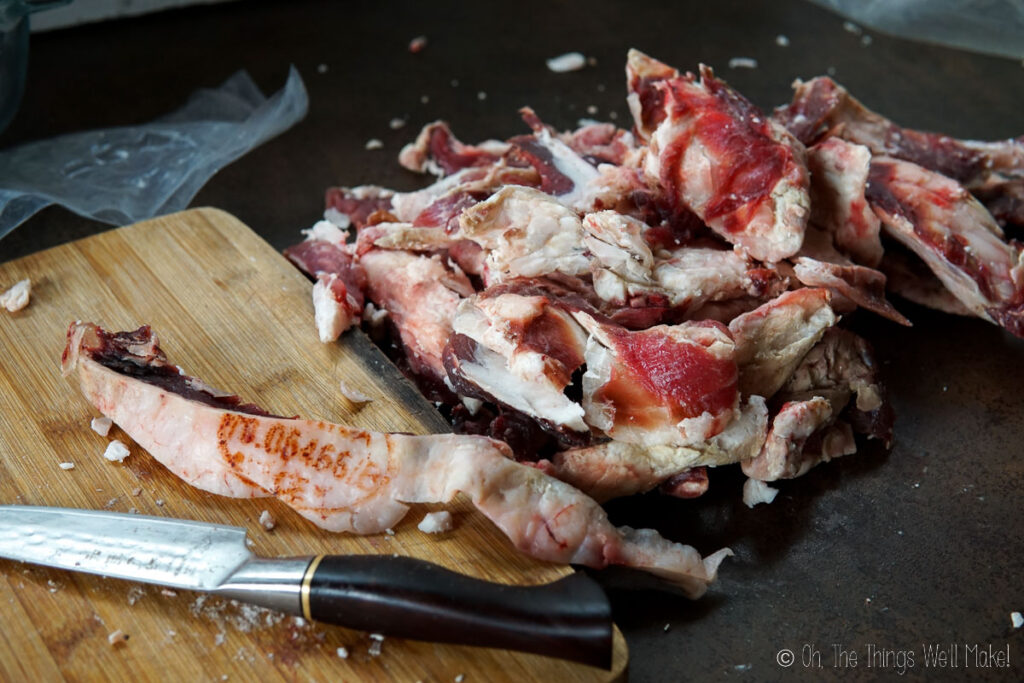
Remove skin, bones, and excess meat. 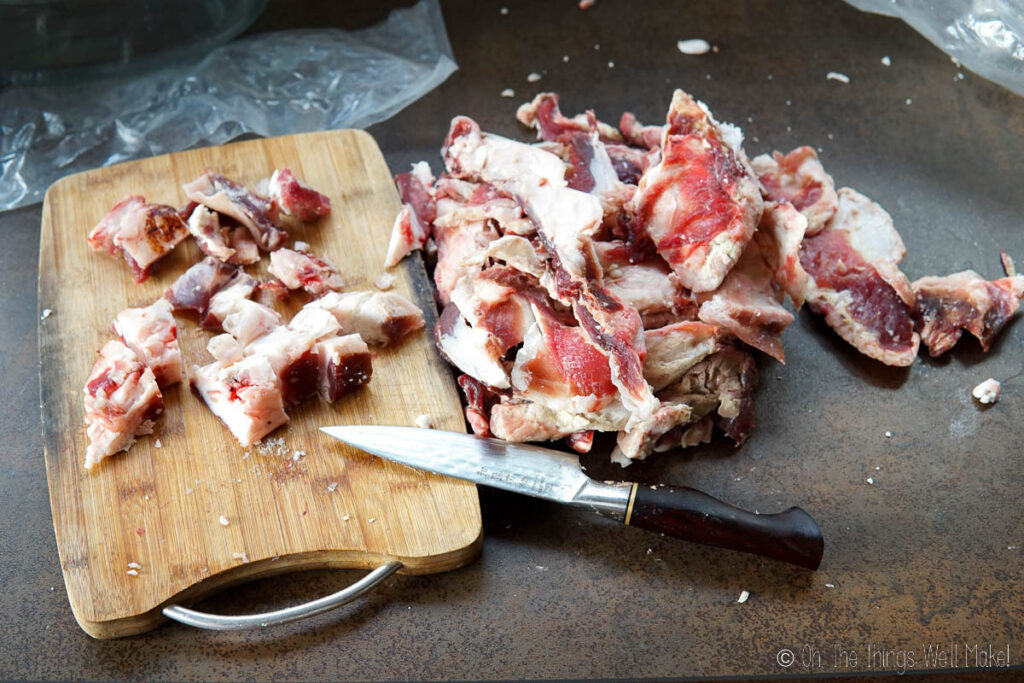
Cut fat into chunks. 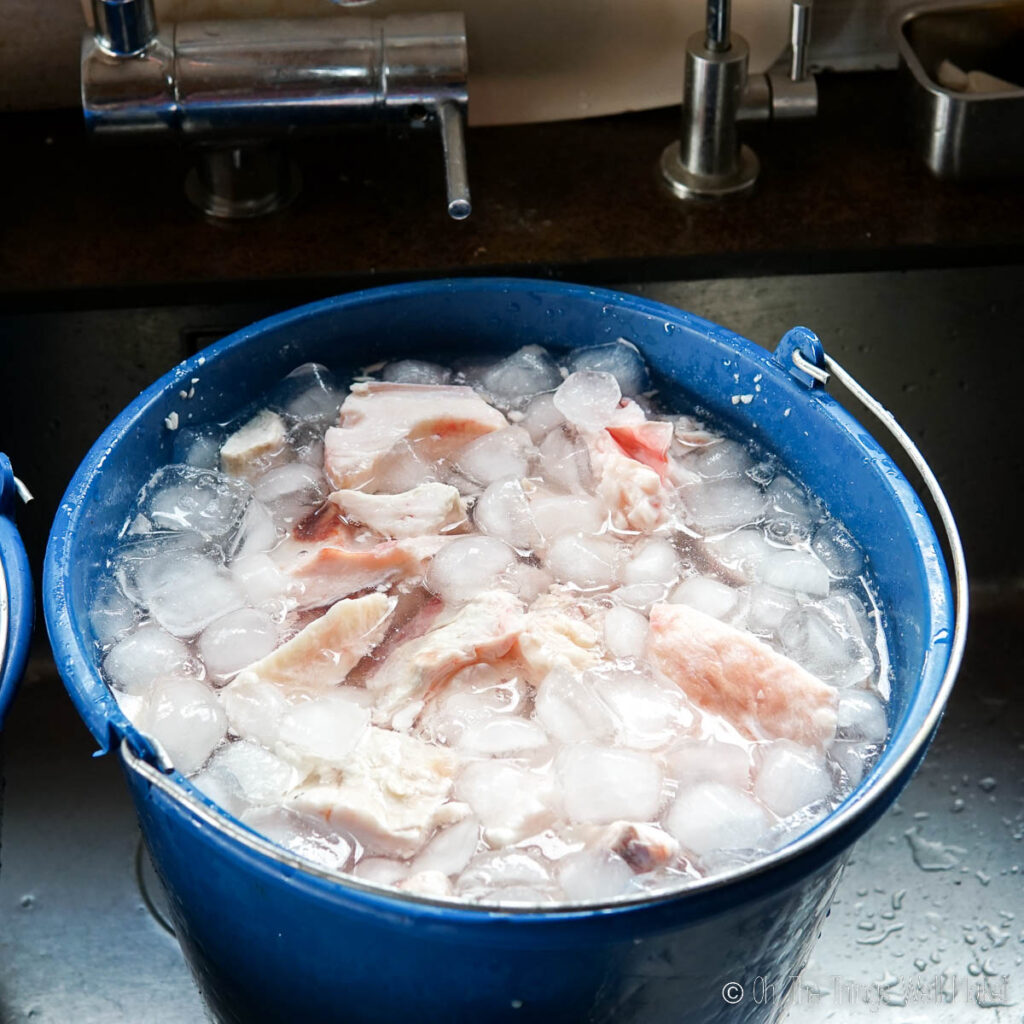
Soak in ice water. 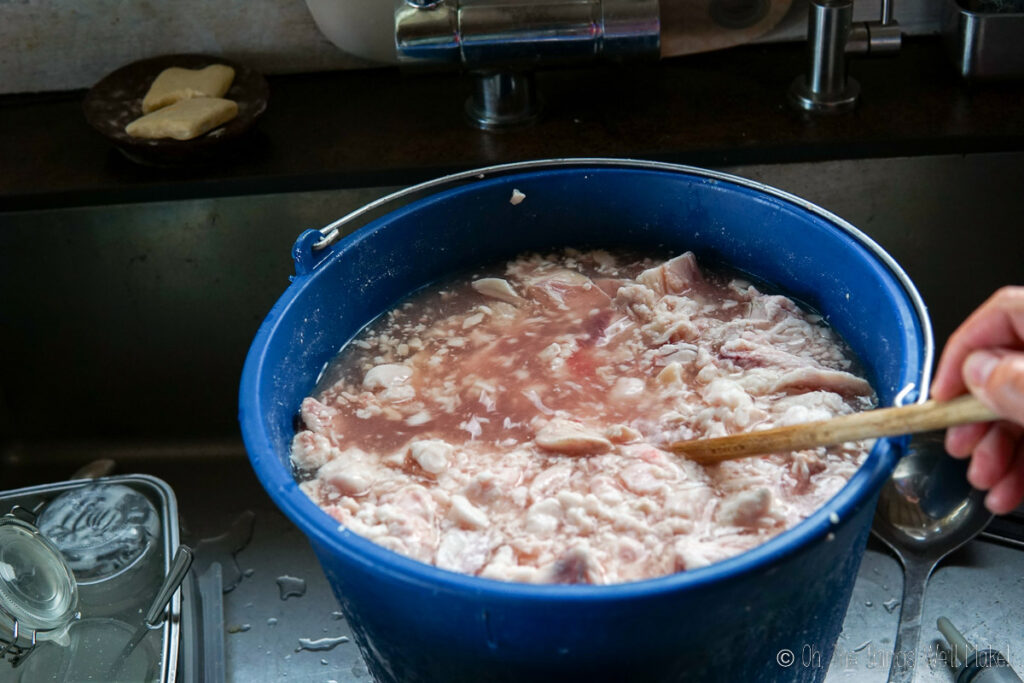
It will release blood and impurities. 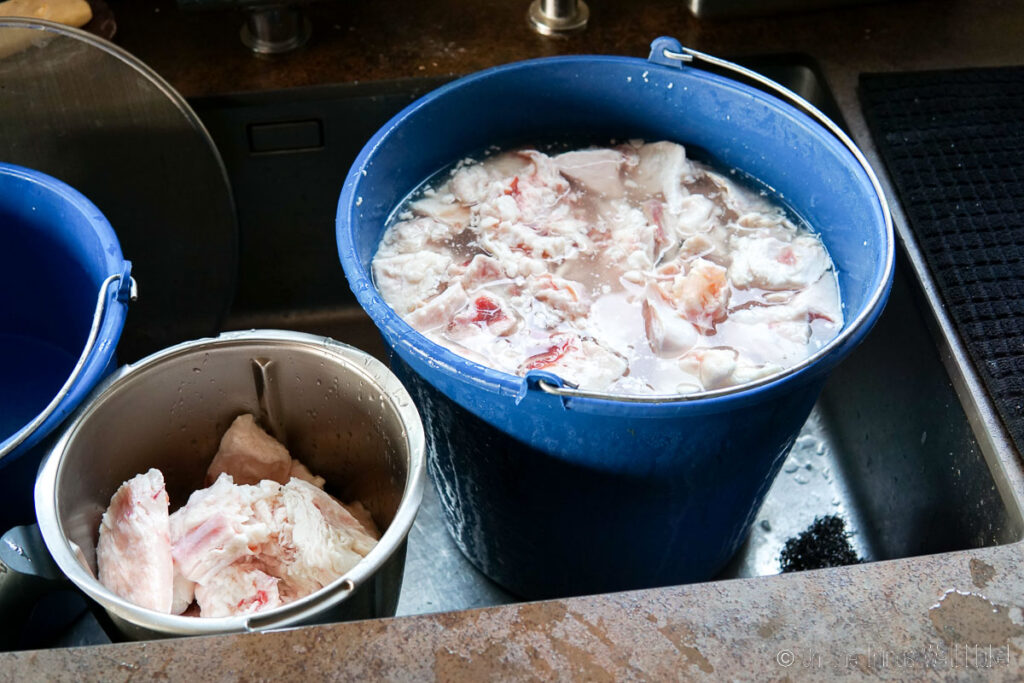
Optionally grind up the clean fat. 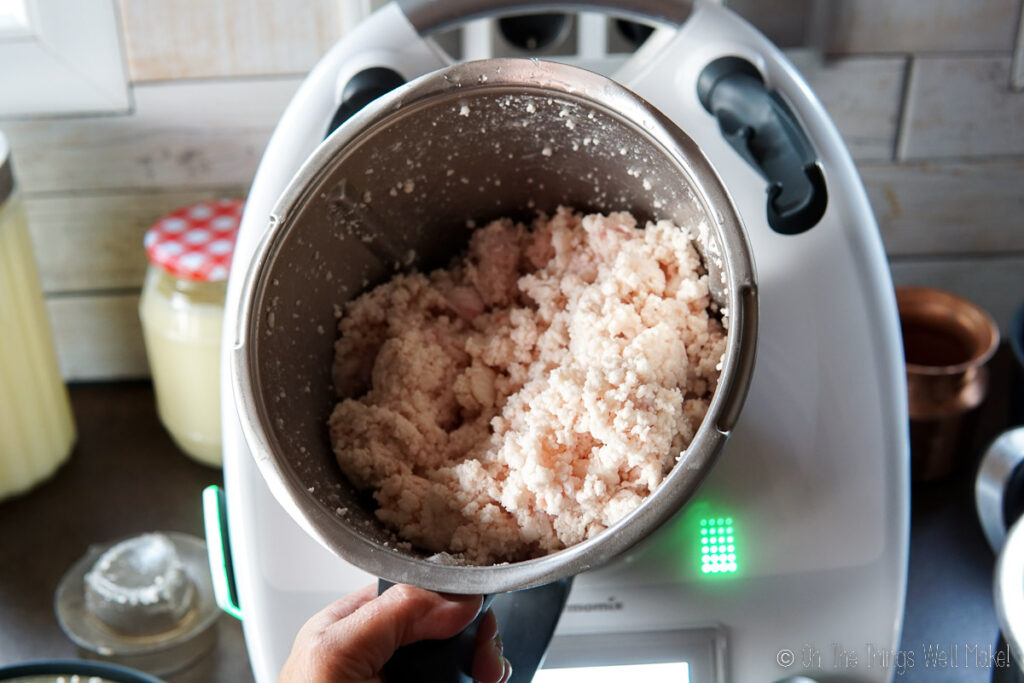
Render the fat
Place the cut fat into a large pot and get it over very low heat. You may also use a slow cooker for this part, but, keep in mind, that it will generally take longer when using a slow cooker. The advantage is that a slow cooker uses such low heat that it is very unlikely that you will overheat the meat. If too high of heat is used, the finished tallow may have more of a toasted/cooked flavor and the tallow could darken in color.
Patiently cook the fat, allowing it to liquefy and begin to simmer. Don’t allow it to reach a hard boil, but a gentle simmer is fine. You can periodically strain off some of the liquid fat or just periodically stir it, scraping the sides and bottom of the pot to keep stuck pieces from burning. Once most of the fat has rendered into a yellowish liquid, take the pot from the heat and prepare a jar for storage.
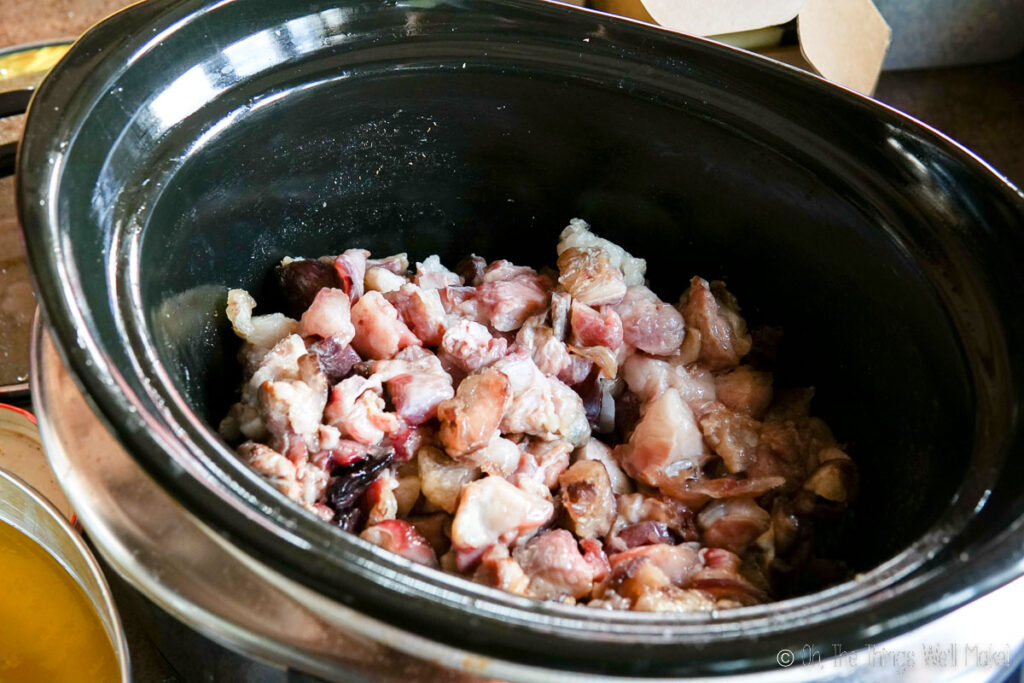
Add fat pieces to a slow cooker or pot. 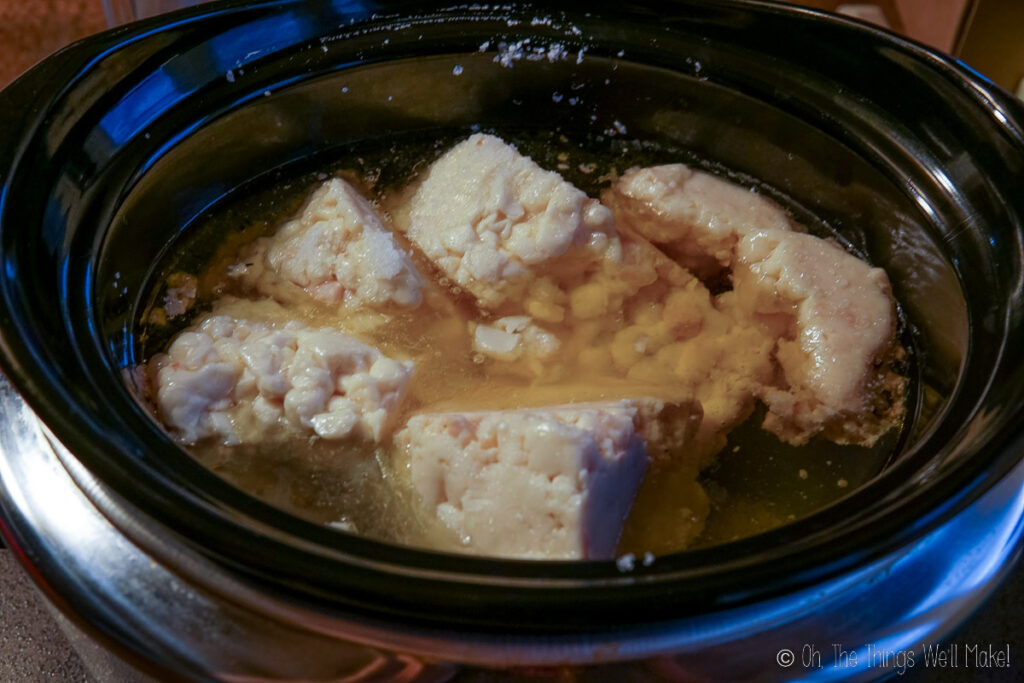
Heat until it liquefies. 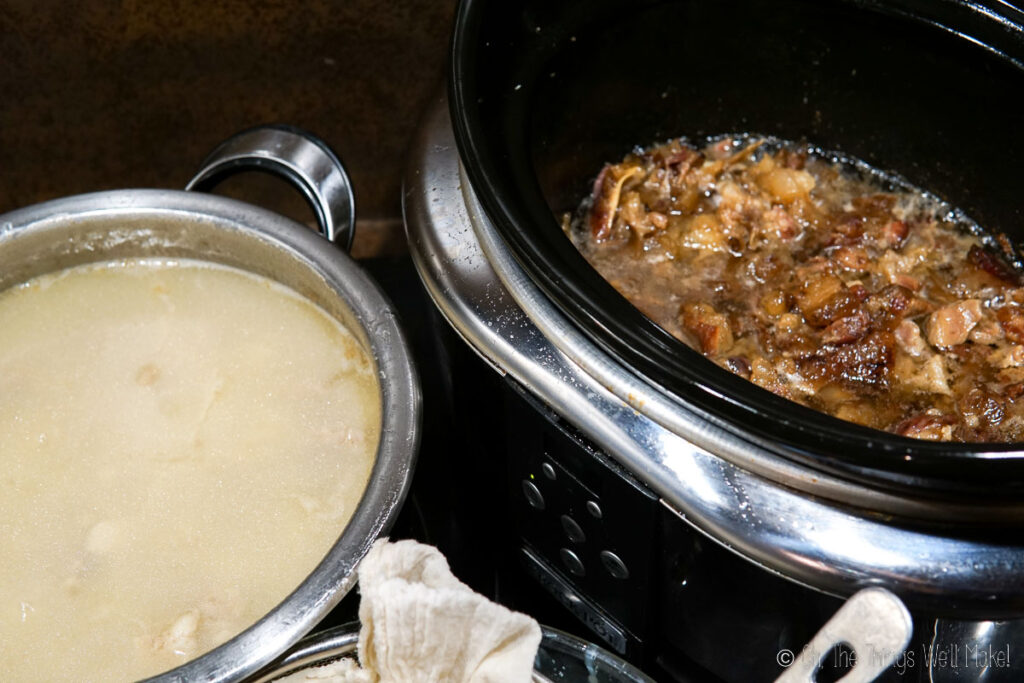
Strain the tallow
Strain the fat by pouring it into a strainer lined with a piece of cheesecloth or other clean cotton cloth with a fine weave. (You can also use a coffee filter, but I’d reserve that until after filtering out any remaining bits of meat with a strainer.) I like to place the strainer in a funnel to help funnel the tallow into the jar. When the liquid fat cools, it will lighten and become opaque.
Any remaining impurities (or salt water, if you cooked your fat with salt and water) will fall to the bottom of your container. So, if you want to obtain a very clean tallow, consider pouring your strained tallow into a wide-mouth, slightly flexible bowl. (I use stainless steel.) Once the tallow has hardened, pop the tallow out of the bowl and cut off any darker impurities on the bottom. (If you cooked your suet with water, the water will be on the bottom of the bowl, so be careful when you pop out your tallow.)
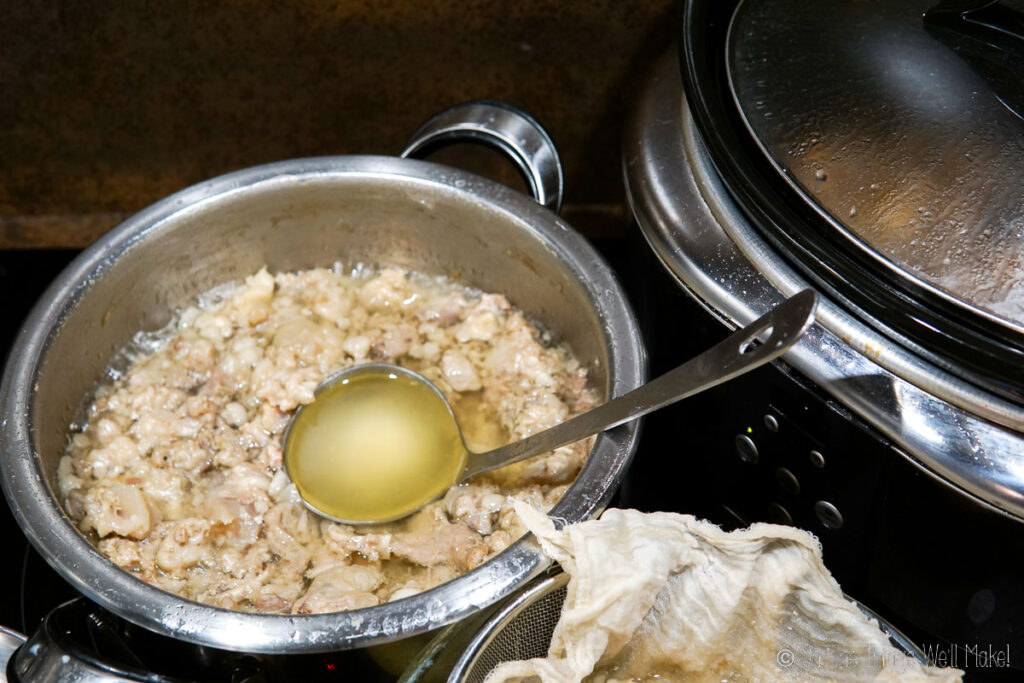
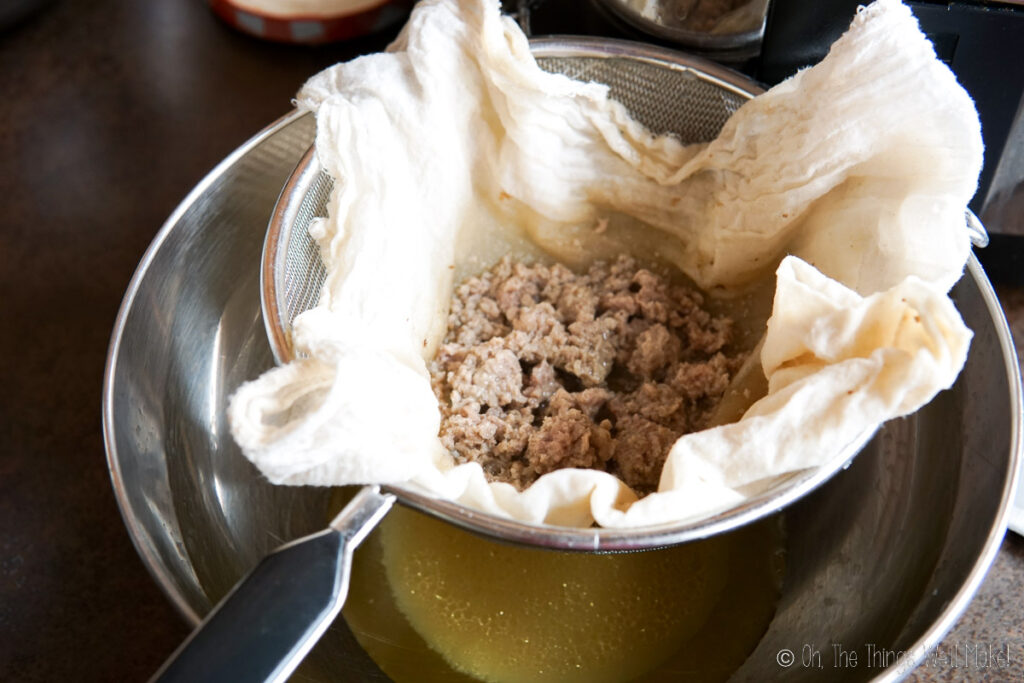
Filtering meat solids from the tallow 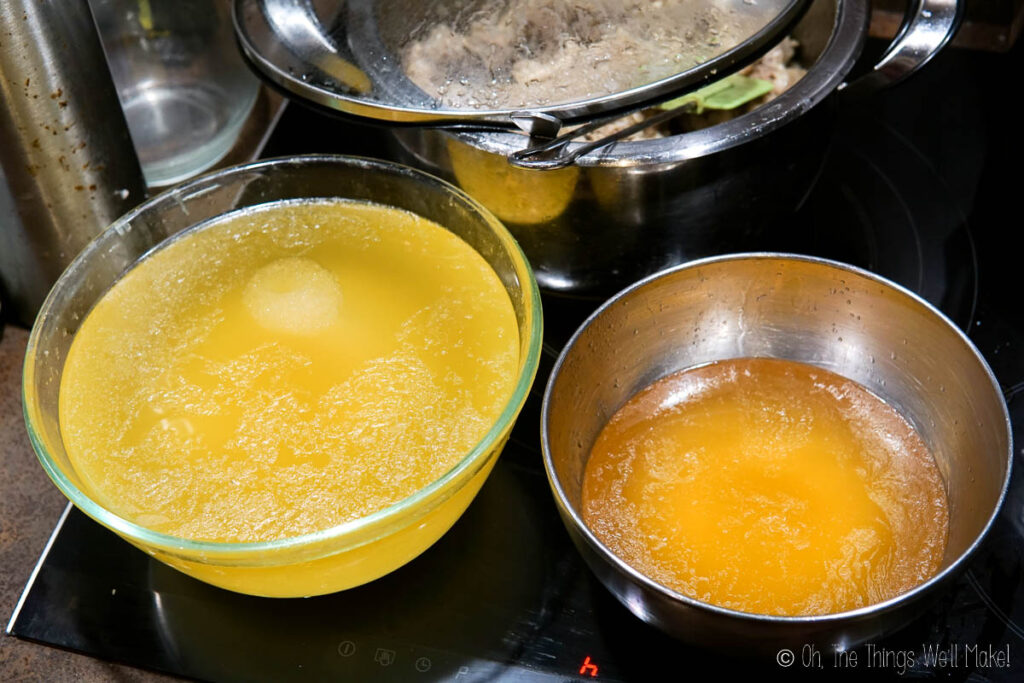
Two different batches of tallow 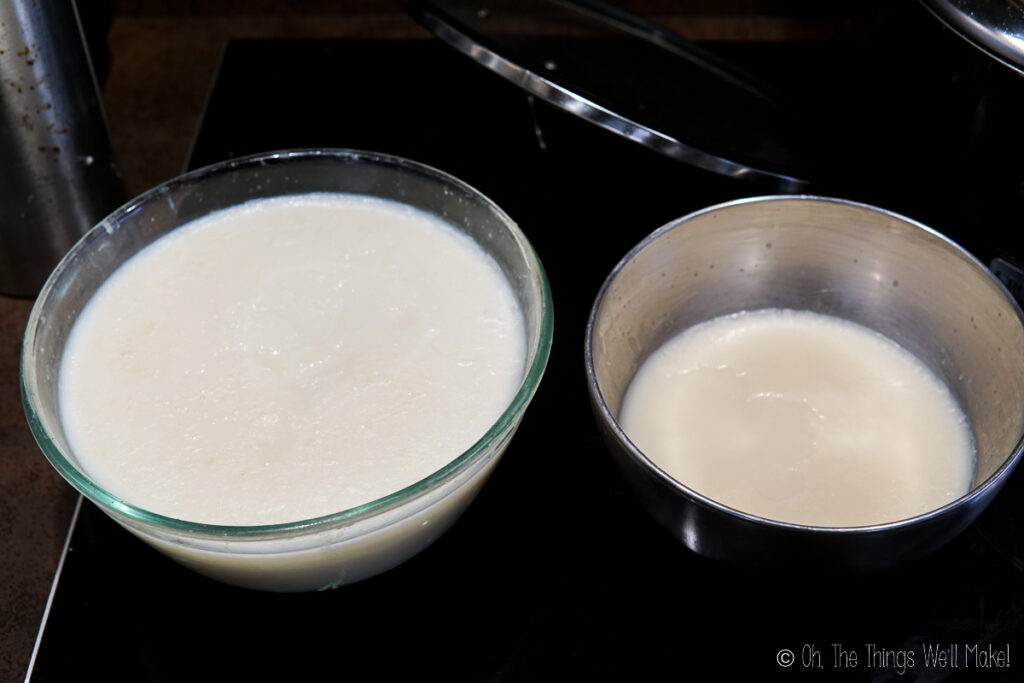
Tallow gets opaque and white when it cools.
Removing the gelatin
While most of the gelatin, water, and other “impurities” will fall to the bottom, a skin may also form on the top of the tallow while simmering. (It will depend on where you cut the fat from, and how much meat and connective tissue remains.)
If foam forms over the surface of the simmering tallow, allow it to cool and you should be able to easily remove the hardened skin. Repeat the cycle of simmering the fat and removing the skin until no more foam forms. That will allow you to obtain a clean, clear tallow.
Depending on how much water you add (and the cuts of fat used), you may end up with a thick, nourishing gelatin below your tallow. Feel free to save this and add it to broths or other dishes.
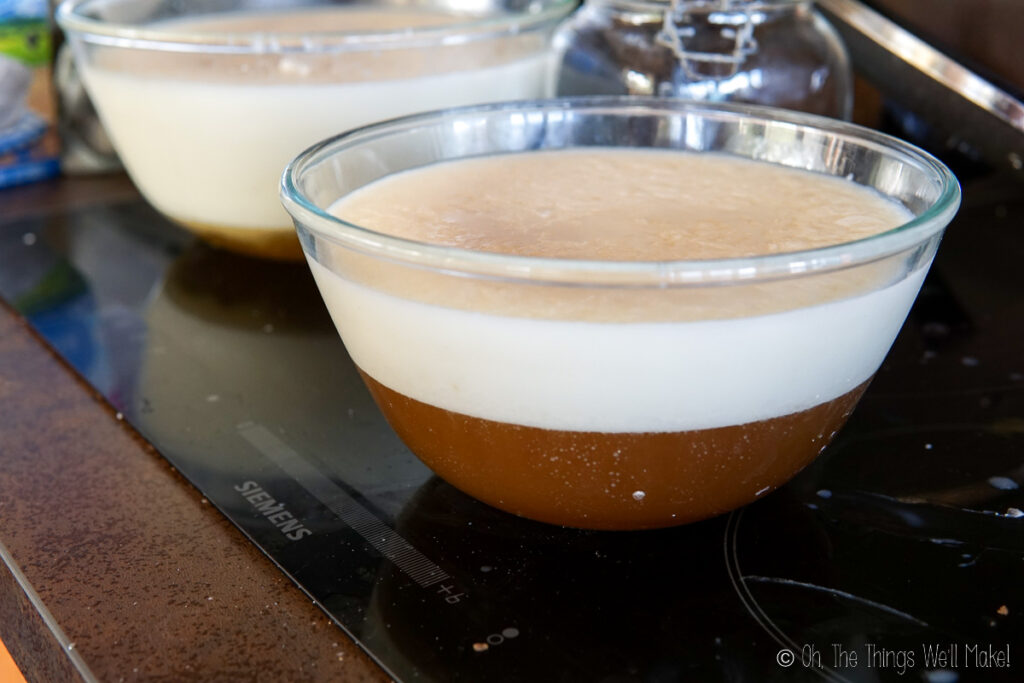
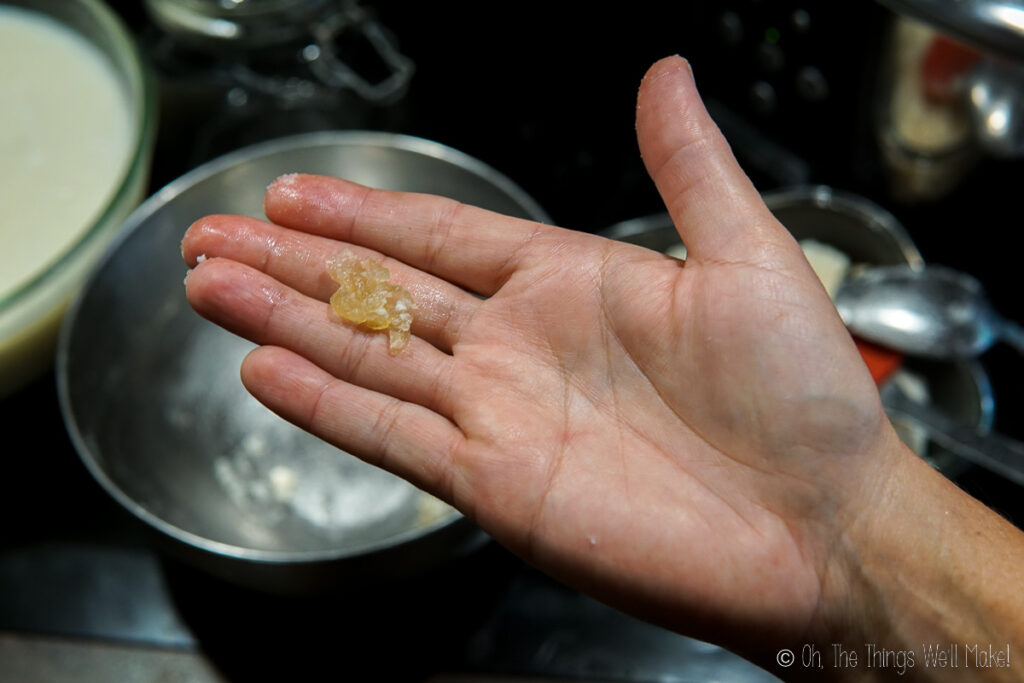
Gelatin from below the tallow 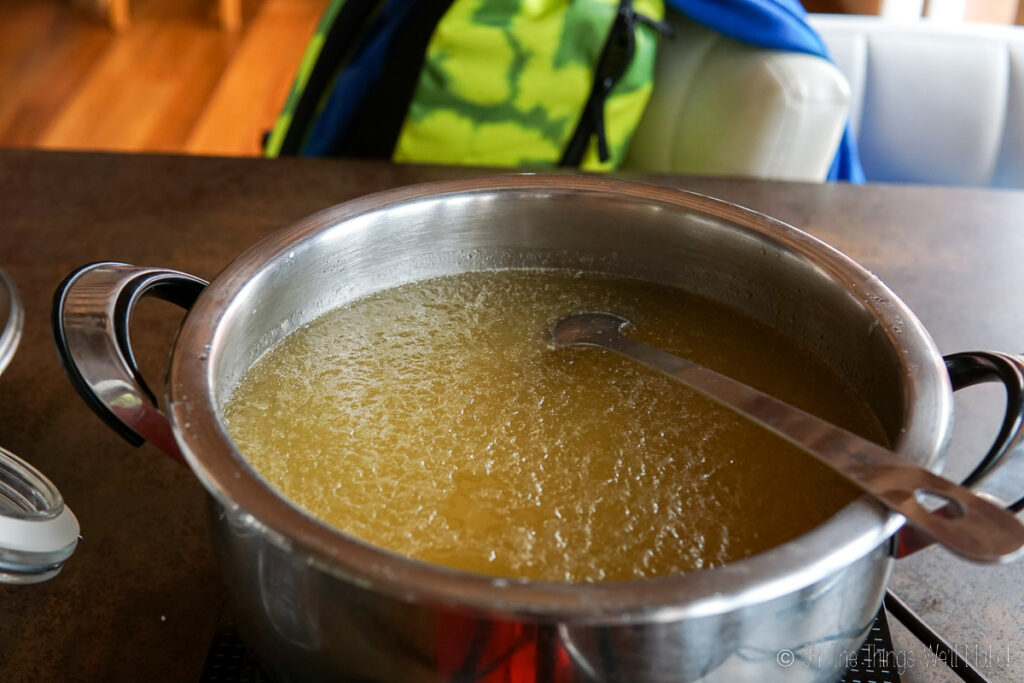
A skin may form on the surface. 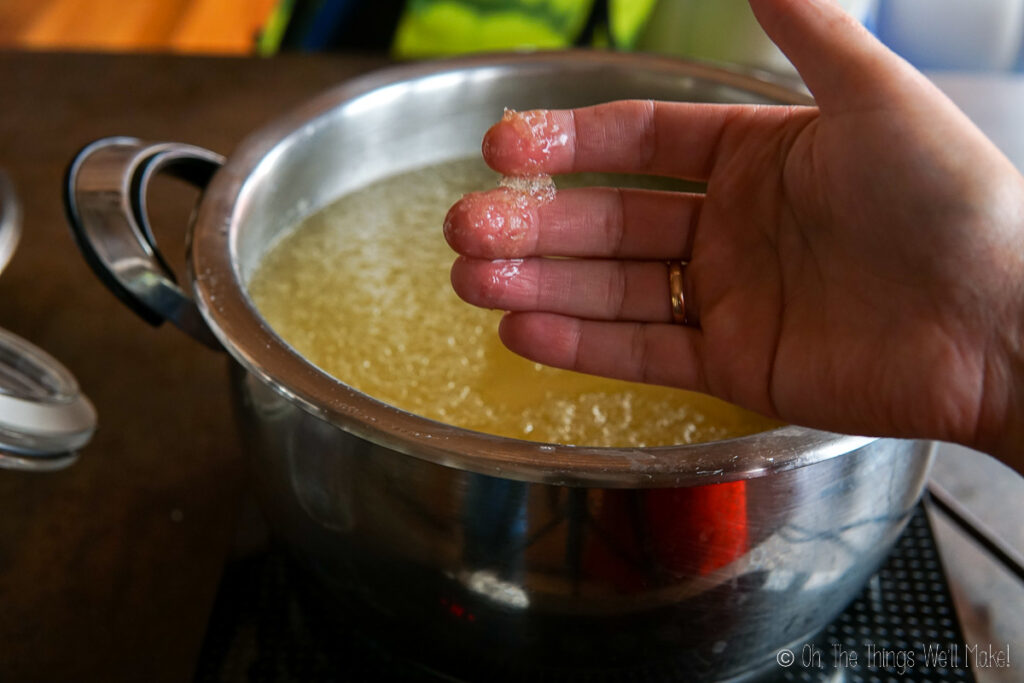
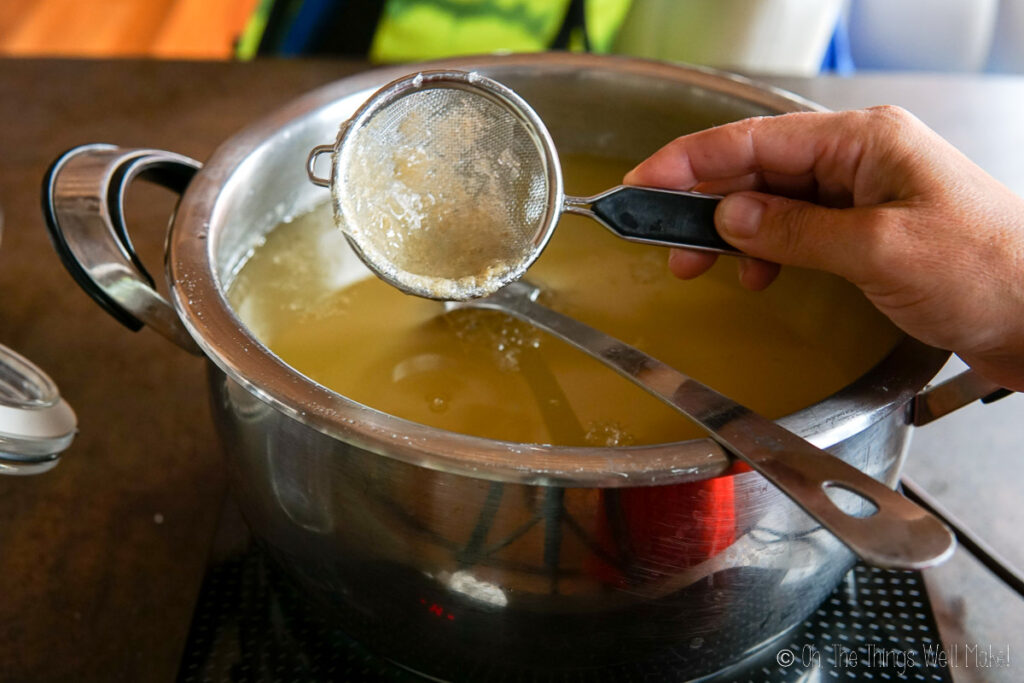
Simmer it and skim it off. 
Or allow it to cool and pull it off.
Purifying tallow with salt and water
I had read in several places that to get a very pure, white tallow, you should slowly cook the tallow with water and salt. I did some experimentation and didn’t find that I got any benefit from using salt and water. In fact, it took much longer to render and the process was much messier.
Even when cooking off as much water as possible, or separating the solid tallow from the liquid below and slicing off the impurities, I ended up with a softer, grainier tallow that likely had some water remaining inside. (This could reduce the shelf life or even allow for mold growth.)
To fix the issue, I melted down the finished tallow, allowing it to cook and evaporate off any remaining water. The resulting tallow was much harder and smoother.
If you’d like to obtain a very clean, white, solid tallow, consider rendering the tallow and removing the impurities by scraping them off the bottom and removing them from the surface. Then, repeat the process one more time before remelting it and pouring the finished liquid tallow into its final storage container.
Getting a pure white tallow
The cooking process you use to make your tallow isn’t the only factor that affects the final color. While overcooking the tallow could lead to a slightly darker-colored fat, the type of fat is also a major factor.
Tallow obtained from young animals will be whiter in color than that obtained from older animals. I noticed a difference between the tallow obtained from the fat that my friend gave to me (whiter) and the wagyu fat I bought online (that supposedly came from older animals). I later learned that they had specifically sent me fat from younger animals in case I needed a whiter tallow.
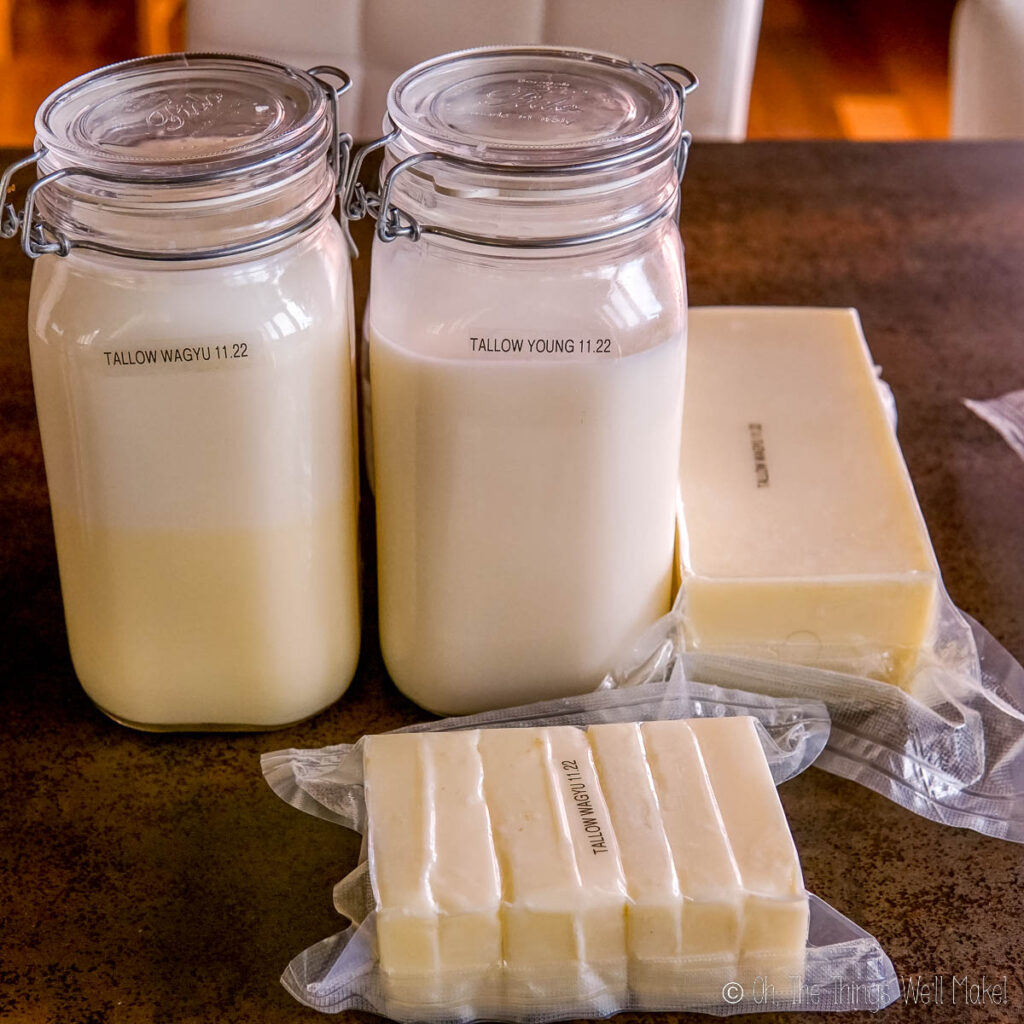
Interestingly enough, I remelted the yellower tallow to try to make it less grainy. (I had cooked that batch with salt and water and I wasn’t happy with the results.) After cooking the tallow a second time, the difference in color wasn’t as noticeable. So, if your tallow isn’t as white as you would like for a specific project, try remelting it. By simmering it and removing any impurities, you may be able to whiten it slightly.
Uses
Tallow is an extremely useful fat. It’s one of my favorite cooking fats, but it is also beneficial for use in cosmetics and soaps. It can even be used for making tallow candles!
Tallow soap
Tallow is one of the few fats that can make a decent bar of soap when used on its own. Olive oil is the only liquid oil that I’ve ever used alone in a bar of soap. While pure Castile soap (made with only olive oil) is very gentle and “conditioning”, it isn’t as effective at cleaning and doesn’t leave you feeling “squeaky clean”. In fact, some people find Castile soap “slimy”.
Coconut oil and animal fats are solid at room temperature (if cool enough) because of their high concentration of saturated fats. These fats make a much harder bar of soap that does a better job of cleaning.
Tallow makes a nice cleansing, long-lasting bar of soap that gives a creamy lather. You can also combine it with other oils and fats to get the desired properties of your soap.
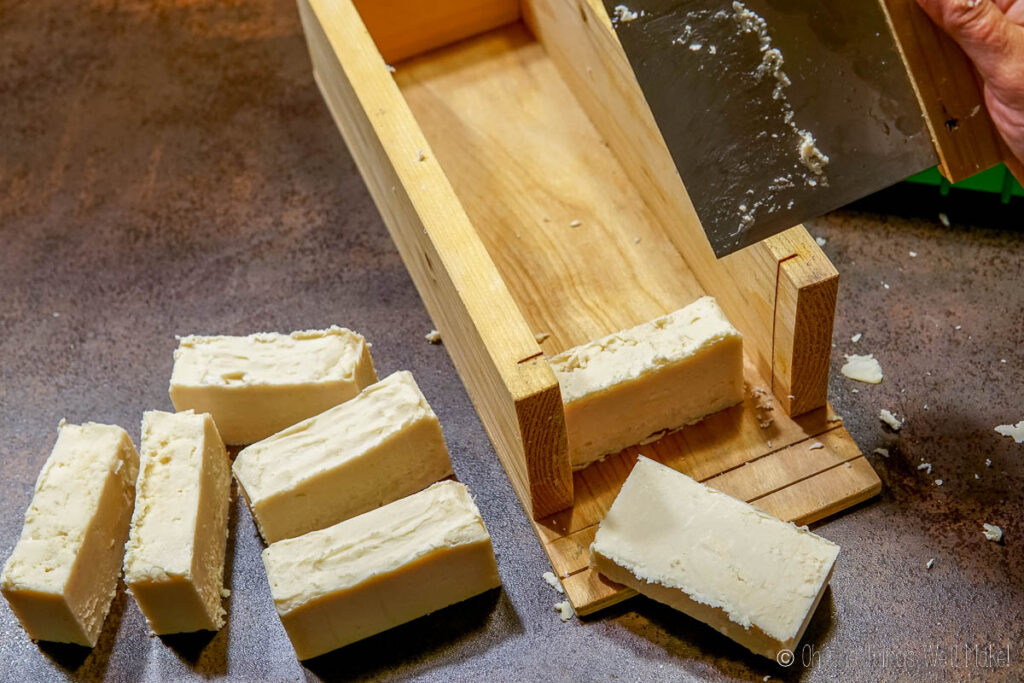
Tallow soap 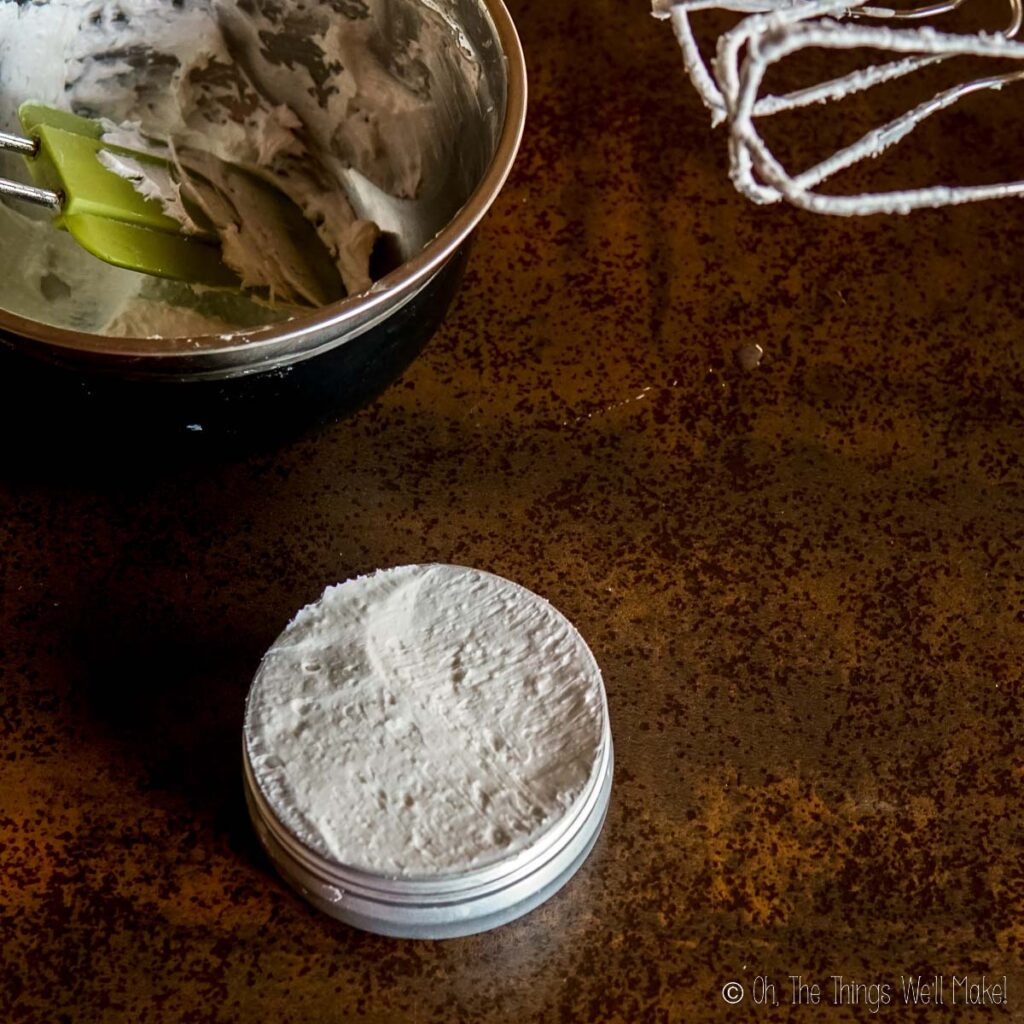
Whipped tallow balm
Whipped tallow balm and lotion
Because tallow is similar in composition to our own fat, it’s ideal for use in skincare. While tallow balm may seem like it would be heavy and occlusive, our skin absorbs it quickly. So, it actually feels light once applied. It helps soothe dry skin and repair damage.
It can be whipped, alone or with another oil, into a simple body butter. Because tallow has a mild odor on its own, adding some essential oils can give the butter a pleasant scent. I thought that using tallow butter would be offputting. But, despite the fact that I normally prefer making lotions to making body butters, tallow butter (aka. tallow balm) is actually becoming one of my favorite skincare products lately.
Cooking with tallow
Tallow is a very stable fat that can withstand high-heat cooking without oxidizing. It has a high smoke point (420ºF/215ºC) and doesn’t break down easily, so it’s great for frying. In fact, McDonald’s french fries were originally fried in mostly tallow (with a touch of vegetable oils) before saturated fats were erroneously vilified in the media.
Tallow is also great for baking and sautéing. It adds a nice, mild flavor to dishes and can be used in place of butter or other fats. It’s especially good for making pastries, as it gives them a flaky texture.
Nutritional benefits of beef tallow
While saturated fats have been vilified in the past, newer studies are questioning if that was actually sound advice. There are many anecdotal cases where people analyze their blood before dramatically increasing the saturated fats in their diet (like when trying a carnivore diet). Generally, while the LDL number may increase, the fatty lipid profile actually improves dramatically (lowered triglycerides and raised HDL).
Tallow is an excellent source of vitamins A, D, E, and K2. It also contains conjugated linoleic acid (CLA), which has been linked to a variety of health benefits including weight loss and improved heart health. Grass-fed beef tallow is especially beneficial nutritionally.
Storage
Store your homemade beef tallow in an airtight container in a cool, dark place for the longest shelf life. You can also refrigerate it or freeze it for longer storage. When refrigerated, it should keep for up to a year. When frozen, it can keep for up to two years. You can extend its shelf life even more by vacuum-sealing the tallow.
A convenient way to store tallow long-term is to form blocks of tallow by pouring the liquid tallow into a silicone loaf-shaped soap mold. Once it hardens, I vacuum-seal the blocks of tallow and freeze them.
Video tutorial
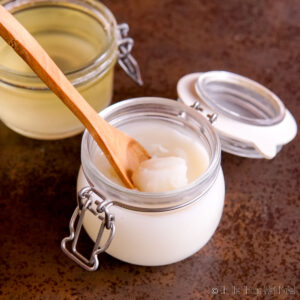
How to Make Beef Tallow
Instructions
- Start by removing any skin, bones, and large pieces of meat. Cut the fat into large chunks.
- If the fat isn't as white as you would like, soak it in ice water for about an hour.
- Cut the beef suet into small cubes or grinding it up. This will help it render more quickly.
- Place the fat in a large pot over medium heat and simmer it for several hours, stirring occasionally to prevent it from burning. (You can also use a slow cooker if you prefer.)
- Once the fat has liquified, strain it through a cheesecloth or fine mesh strainer to remove the remaining meat and other tissues.
- Pour the liquid fat into a heat-proof container and let it cool until it solidifies. (Use a wide-mouthed flexible container if you plan to further purify it.)
Purifying the tallow
- To further "purify the tallow", once cooled, scrape off any remaining solids that have sunk to the bottom of the tallow. (Also scrape off the top, if necessary.)
- When melting the tallow, bring it to a simmer. If a foam forms on top, allow the tallow to cool and remove the skin that forms over the surface.
- Repeat the process until foam no longer forms when simmering the tallow.
- Strain and pour the finished tallow it into its final storage container.
- Allow the tallow to cool before covering and storing it.
 Español
Español
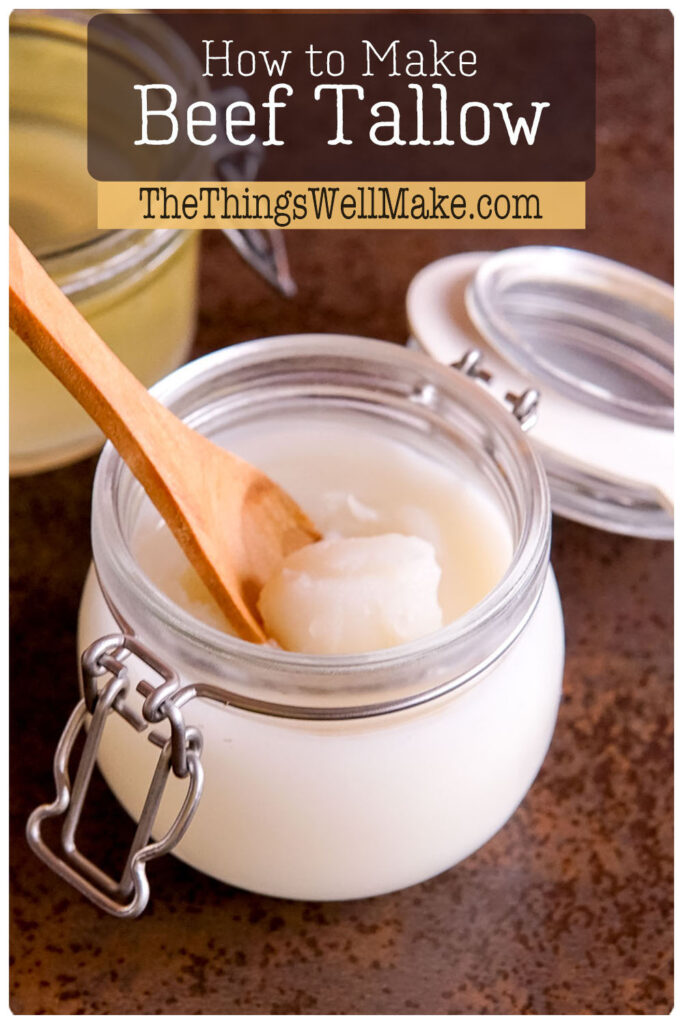
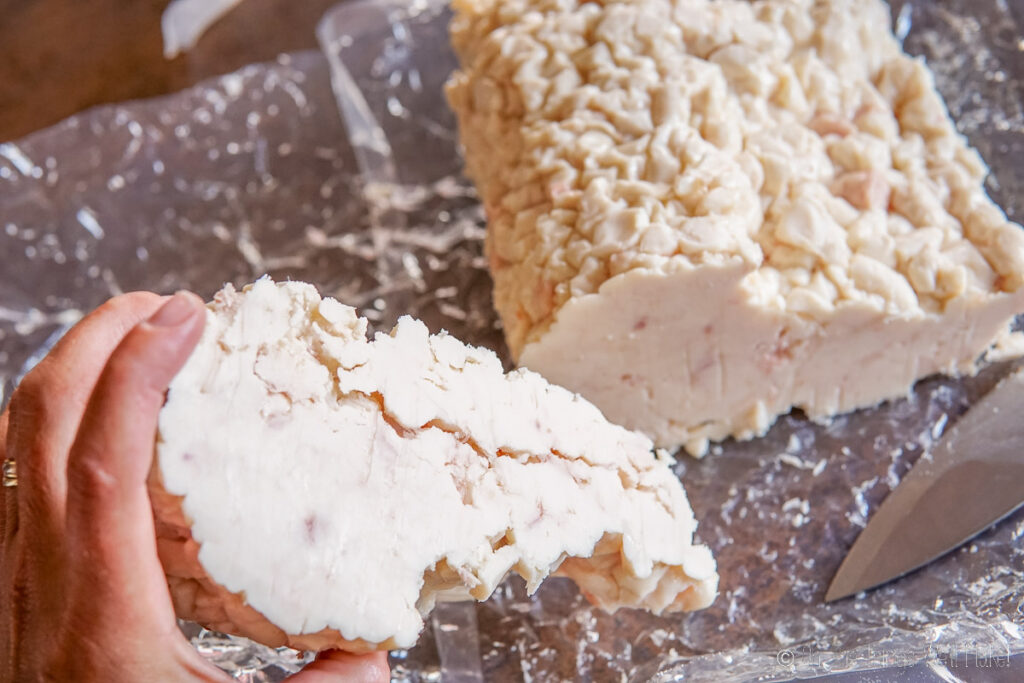
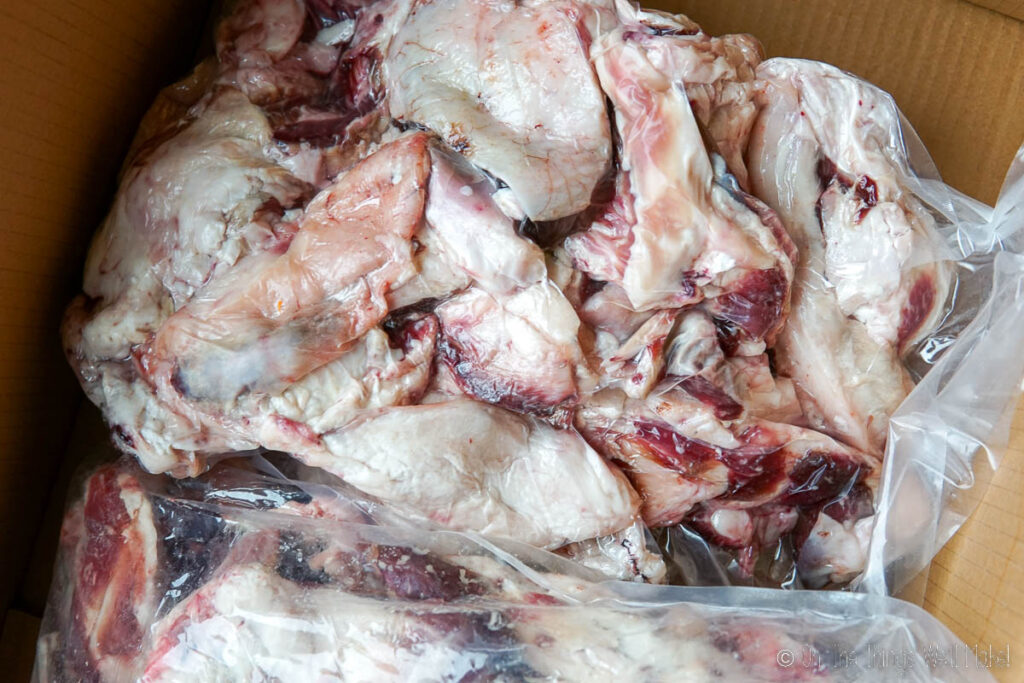
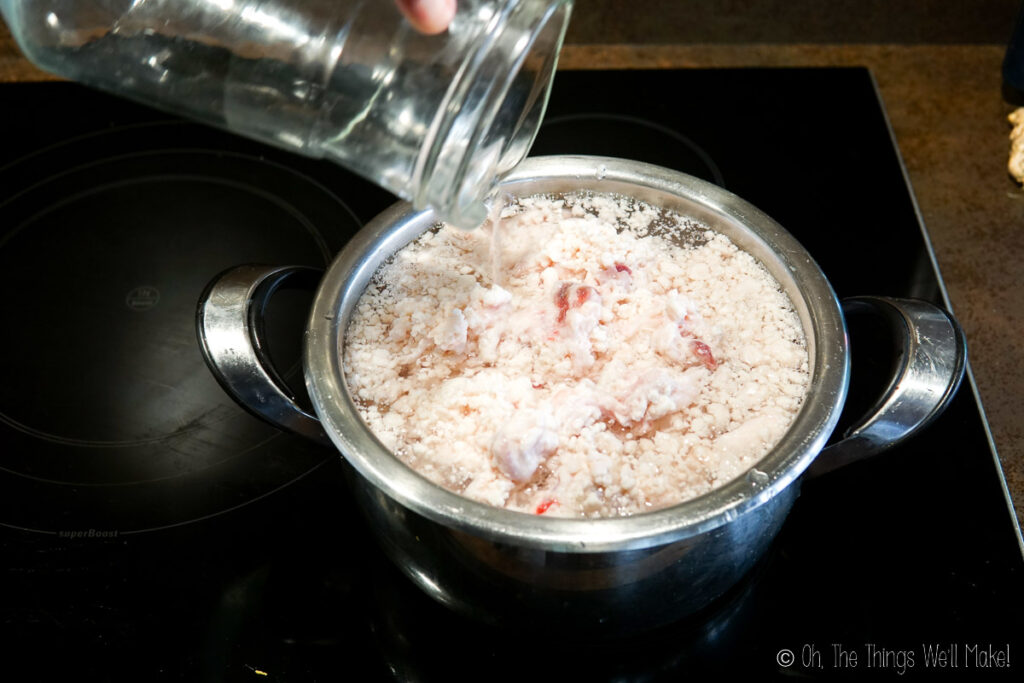
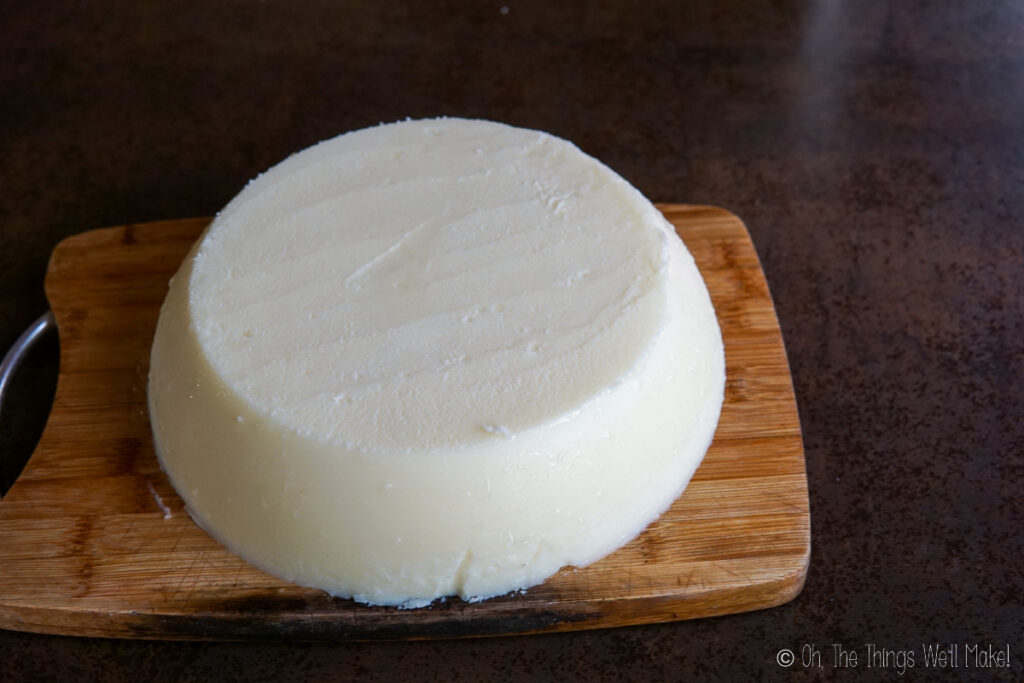
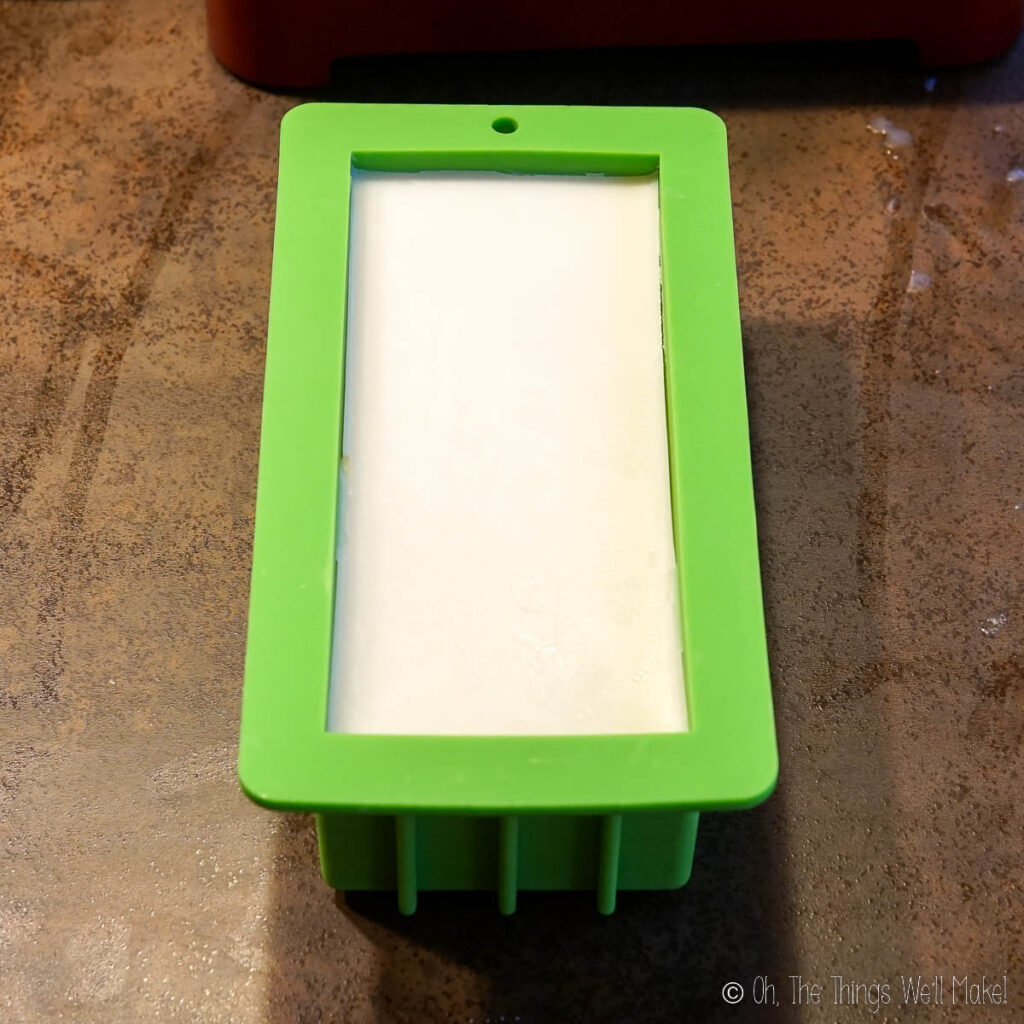
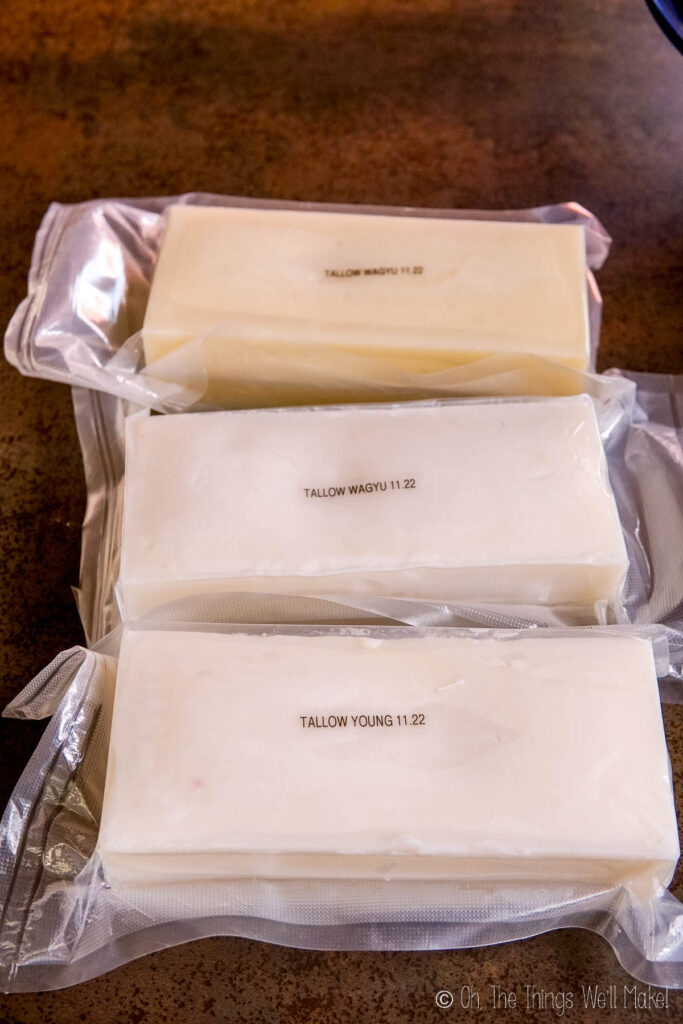
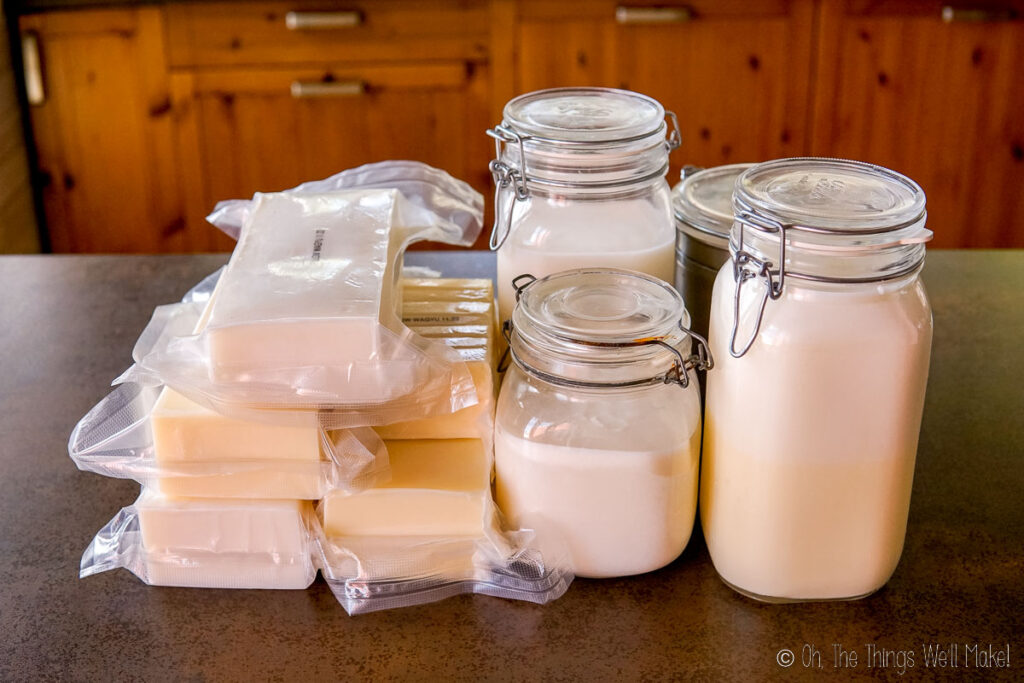
 How to Make a Leather Purse
How to Make a Leather Purse
Leave a Reply